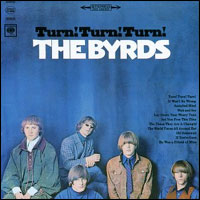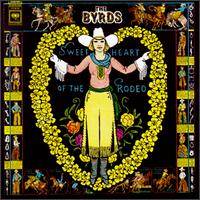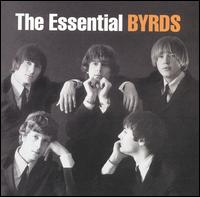|
Music Reviews
Alternative
Blues
Books
Christmas
Classic Rock
Country
Jazz
Lounge
Oldies
Power Pop
Punk & New Wave
Reggae
Rhythm & Blues
Seventies
Texas
Special Features
Randy's Rodeo
Sex Pistols
Motown
Halloween
Valentine's Day
Information
About Me
Feedback
Links
User's Guide
Support Me
Amazon
iTunes
Sheet Music Plus
|
Sock it to me, Santa! Visit my other website, www.hipchristmas.com Visit my other website, www.hipchristmas.com
 The
Byrds were a marvelously synergistic, incredibly influential band. They
began when some folk musician's tried to emulate rock music; the result was
alchemy, mixing the two disciplines to create a third. To paraphrase leader
Roger McGuinn, the Byrds whooshed like a jet plane where rock had formerly
chugged along train-style. It was McGuinn's 12-string Rickenbacker - along
with the group's seamless, soaring harmonies - that made "Mr. Tambourine
Man" and "Turn Turn Turn" sound so good on the radio. That
they were introducing teeny boppers to Bob Dylan and Pete Seeger was just
a bonus. McGuinn, of course, wasn't the only Byrd - but over the years his
trademark jangle, moptop hair, and goofy granny glasses came to represent
the group in the public's eye. The
Byrds were a marvelously synergistic, incredibly influential band. They
began when some folk musician's tried to emulate rock music; the result was
alchemy, mixing the two disciplines to create a third. To paraphrase leader
Roger McGuinn, the Byrds whooshed like a jet plane where rock had formerly
chugged along train-style. It was McGuinn's 12-string Rickenbacker - along
with the group's seamless, soaring harmonies - that made "Mr. Tambourine
Man" and "Turn Turn Turn" sound so good on the radio. That
they were introducing teeny boppers to Bob Dylan and Pete Seeger was just
a bonus. McGuinn, of course, wasn't the only Byrd - but over the years his
trademark jangle, moptop hair, and goofy granny glasses came to represent
the group in the public's eye.
The Byrds quickly progressed; by "Eight Miles High," they had completely
loosed themselves from the clutches of traditional music, creating wholly original
rock tinged with psychedelia. As band members (most notably Chris Hillman,
Gene Clark, David Crosby, Gram Parsons, Clarence White, and Skip Battin) passed
through McGuinn's ever rotating door over the years, the evolution continued.
The Byrds quickly move on, returning to roots-based music by embracing country
music, then exploring blues-based rock. The group finally fell apart altogether
in 1973, but the twang and jangle of the Byrds continued with reverberate;
their influence extends through the present via REM, Tom Petty, the Church,
Uncle Tupelo, Radiohead, and more.
 The
Byrds produced eleven albums for Columbia during their career. Starting in 1997, Sony/Legacy
refurbished them all, improving the mastering and packaging and adding bonus tracks.
This makes these individual discs the best way to collect the Byrds. The first seven
CD's - Mr.
Tambourine Man (1965), Turn!
Turn! Turn! (1965), Fifth
Dimension (1966), Younger
Than Yesterday (1967), Sweetheart
Of The Rodeo (1968), The
Notorious Byrd Brothers (1968), and Dr.
Byrds & Mr. Hyde (1969)- are absolutely great. The final four albums were recorded
after all founding members (except McGuinn) had departed. These records - Ballad
Of Easy Rider (1970), Untitled (1970), Byrdmaniax (1971),
and Farther
Along (1972) - found the Byrds settling into a comfortable roots rock groove, and
each has good moments. The
Byrds produced eleven albums for Columbia during their career. Starting in 1997, Sony/Legacy
refurbished them all, improving the mastering and packaging and adding bonus tracks.
This makes these individual discs the best way to collect the Byrds. The first seven
CD's - Mr.
Tambourine Man (1965), Turn!
Turn! Turn! (1965), Fifth
Dimension (1966), Younger
Than Yesterday (1967), Sweetheart
Of The Rodeo (1968), The
Notorious Byrd Brothers (1968), and Dr.
Byrds & Mr. Hyde (1969)- are absolutely great. The final four albums were recorded
after all founding members (except McGuinn) had departed. These records - Ballad
Of Easy Rider (1970), Untitled (1970), Byrdmaniax (1971),
and Farther
Along (1972) - found the Byrds settling into a comfortable roots rock groove, and
each has good moments.
Many versions of these seminal albums have been released on CD, but none have improved
on Sony's original series - except possibly their own two-disc expansion of Sweethearts
Of The Rodeo, featuring dozens of alternate takes and some of Gram Parson's early
work with the International Submarine Band. Sony also released Live
At The Fillmore February 1969 from recently discovered tapes. Finally,
collectors should seek out Sundazed Records' The
Preflyte Sessions (2002), which compiles 40 tracks from the Byrds' early, pre-Columbia
days; it should be noted that Preflyte
Sessions is far superior to other reissues covering the same material, including
the original Preflyte LP
(1969) or Rhino's aging In
The Beginning CD (1988).
It's worth noting that after McGuinn's latterday, ramshackle version of the Byrd's fell apart, the original five members reunited for one album, Byrds, on a new label (Asylum) in 1973. It was roundly criticized at the time - in Rolling Stone, Jon Landau called it "one of the dullest albums of the year" - and it wasn't reissued on CD in America until 2004 (though an imported version wasn't too hard to find). Rather than bad, though, I'd call Byrds curious. Mostly, it doesn't sound like the Byrds (rather ironic considering the title...). It features very little of McGuinn's trademark 12-string guitar - and only minimal harmonies - while adhering to a rather generic country-rock format. More tellingly, several of the songs (Clark's "Full Circle," Crosby's "Laughing," and McGuinn's "Born To Rock 'n' Roll") are recycled from earlier efforts, and three are covers (including a sumptuous version of Neil Young's "Cowgirl In The Sand"). All told, Byrds has some fine moments - most belonging to Gene Clark - but it punctuated the group's soaring career with an anticlimatic, earthbound ellipsis. They wouldn't record together again for over 20 years.
 Short
of collecting all those (superb) Byrd albums on Columbia - which I did - consumers are presented with many choices.
Sony Legacy's remastered Greatest
Hits (1967) would be the sentimental and popular favorite. It's hard to beat that
classic album's eleven songs (now expanded to fourteen); they are among the most important
recordings of the 1960's. But, the CD samples only from the Byrds' first four albums,
telling barely one-third of their story. My personal choice would be Sony's The
Essential Byrds (2003), a two-disc set containing 33 songs, from "Mr. Tambourine
Man" (1965) to "Farther Along" (1972) - something from every original
Columbia LP. The 4-CD boxed set, The
Byrds (1992, now deleted), is very good, too, despite the inclusion of some lackluster
new tracks; if digging that deep, however, I recommend the group's individual albums
rather than the box. Short
of collecting all those (superb) Byrd albums on Columbia - which I did - consumers are presented with many choices.
Sony Legacy's remastered Greatest
Hits (1967) would be the sentimental and popular favorite. It's hard to beat that
classic album's eleven songs (now expanded to fourteen); they are among the most important
recordings of the 1960's. But, the CD samples only from the Byrds' first four albums,
telling barely one-third of their story. My personal choice would be Sony's The
Essential Byrds (2003), a two-disc set containing 33 songs, from "Mr. Tambourine
Man" (1965) to "Farther Along" (1972) - something from every original
Columbia LP. The 4-CD boxed set, The
Byrds (1992, now deleted), is very good, too, despite the inclusion of some lackluster
new tracks; if digging that deep, however, I recommend the group's individual albums
rather than the box.
Even before the Byrds' dissolution, former members began generating numerous solo
and group efforts, most of them quite good and some of them hugely influential. Most
notably, Chris
Hillman and Gram
Parsons founded the Flying
Burrito Brothers who, as much as any artist other than the Byrds themselves, were
responsible for the creation and propagation of country rock. After leaving the Burritos,
Gram Parsons recorded a couple of tremendous solo albums before his untimely death,
while Chris Hillman eventually became a mainstream country star with his bluegrass-influenced Desert
Rose Band. The most underappreciated Byrd, Gene
Clark, released a string of wonderful folk-rock records (summarized to different
degrees on Echoes, American
Dreamer 1964-1974, and Flying
High), while the most overrated member, David
Crosby, joined Crosby Stills & Nash (read more) and
became a (literally) bloated rock superstar (and lesbian baby daddy).
Roger
McGuinn began recording solo shortly after the Byrds' breakup, releasing five
albums through the 1970's; these years are nicely summarized on Columbia's Born
To Rock & Roll (1992). He also reunited with fellow Byrds Chris Hillman and
Gene Clarke as McGuinn
Clark & Hillman, recording several albums (one without Clarke) over the next
few years. McGuinn returned to the spotlight in 1991 with Back
To Rio and has recorded fitfully since. Highlights from the seemingly endless
string of Byrds-related releases were compiled by Raven, an Australian label, on Byrd
Parts and Byrd
Parts Two. [top of page]
|
|